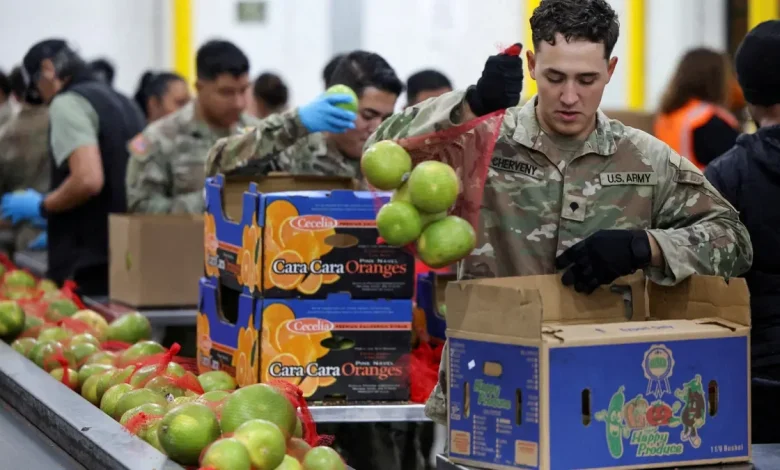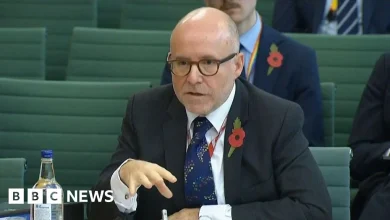Pain from the shutdown keeps worsening. Is a turning point on its way?

Safety-net programs are running out of money. Thousands of government workers are still on the job without pay. And as the holidays approach, major flight delays are growing.
What will it take for lawmakers to reopen the government?
As the government has ground to a halt, millions of Americans face financial uncertainty while essential services hang in the balance.
WASHINGTON – A month into the government shutdown, the consequences of the crisis have been painfully reverberating across the country while jeopardizing the livelihoods of millions of Americans.
As air traffic controllers gear up for their sixth unpaid week, massive travel disruptions due to staffing shortages have become a daily occurrence. More than 60,000 preschool children may see their educational programs cease operations. Hundreds of thousands of federal workers are still off the job, while the employment of thousands more remains in legal limbo.
The rapidly worsening dynamics seem to have jolted lawmakers on Capitol Hill, who after weeks of stalemate have started to take back-channel negotiations about potential shutdown off-ramps more seriously. “There’s been a significant uptick in bipartisan conversations,” said Sen. Lisa Murkowski, R-Alaska. “That’s the good news.”
With flu season approaching, key federal health data is also stalled. Federal courts have slowed down their operations. Immigrants waiting on visa approvals are being told to wait longer.
And the circumstances are only getting more dire: Roughly 42 million Americans won’t get additional food assistance in the first week of November. That’s because funding for the Supplemental Nutrition Assistance Program, or SNAP, is expiring for the first time in history. Lawmakers in Congress and the White House haven’t coalesced around any bills or workarounds to save it while the government is still mostly shuttered.
No bonafide agreements have emerged just yet to reopen government, though. And it’s unlikely that Republicans, Democrats and President Donald Trump, newly back from a week-long trip to Asia, will come together to strike a deal in time to prevent more Americans from getting hurt.
But for the first time since the shutdown began Oct. 1, lawmakers are facing big consequences if they don’t figure out a way to reopen the government soon. “I always try to be optimistic,” said Sen. Gary Peters, D-Michigan. “We still have work to do.”
Lawmakers wary of food stamp crisis, travel delays
Arguably the biggest pain point on lawmakers’ minds is the expiration of food assistance benefits.
Joel Berg, the CEO of Hunger Free America, has warned the impending crisis will be the “greatest hunger catastrophe in America since the Great Depression.” The situation is so bleak that one SNAP-reliant tribal reservation in Montana has resorted to culling its buffalo herd for food.
In recent days, both Democrats and Republicans have desperately tried to avoid the SNAP funding cutoff, introducing competing measures to insulate the program from the shutdown. Yet none of those efforts have gained any real traction. GOP leaders in Congress have so far opposed standalone bills, even to fund SNAP, to soften the blow of the ongoing crisis.
“The president has lamented this,” House Speaker Mike Johnson, R-Louisiana, said Thursday, Oct. 30. “But the money doesn’t exist to do it.”
Meanwhile, delays in travel are intensifying. The Federal Aviation Administration cited staffing issues on Wednesday, Oct. 29, when it ordered a ground stop at Newark Liberty International Airport, a vital transportation hub. All flights to Los Angeles International Airport were briefly halted for similar reasons last weekend.
Vice President JD Vance and Transportation Secretary Sean Duffy met at the White House Thursday, Oct. 30, with airline industry leaders. Vance concluded after the sit-down that the shutdown is “causing way too many problems.”
“Everybody here is very worried that we’re going to see more delays, more stresses on the people who are actually making the aviation system run,” he said.
The disruptions have even affected some lawmakers. Sen. Susan Collins, R-Maine, told reporters she had two flights averted at the last second in recent weeks – something that’s never happened to her while she’s been a senator.
“I fly twice a week,” added Sen. Rand Paul, R-Kentucky. “I want my air traffic controllers to be happy, well fed, not anxious, not nervous.”
Vibes shift on Capitol Hill
Democrats’ main sticking point in the shutdown fight continues to center around what they’ve characterized as a looming health care crisis.
Health insurance subsidies through the Affordable Care Act are set to expire at the end of the year, raising premiums for millions of Americans. At the leadership level, Republicans have promised Senate Democrats a vote on extending the subsidies if they help reopen the government first. So far, Democrats have said they need more than just a guaranteed vote – the outcome of which would be uncertain – to change their minds.
As the shutdown drags on, though, some are starting to sound more hopeful about a solution.
“It’s not just notifying the public what the problem is. We’ve got to fix it,” said Sen. Dick Durbin, D-Illinois. “That doesn’t mean it can’t change tomorrow. There’s always room for compromise.”
A turning point in the shutdown could come as soon as next week, suggested Sen. John Hoeven, R-North Dakota.
While the jumpstarted discussions among rank-and-file lawmakers could spell the beginning of the shutdown’s end, some are skeptical the talks will yield anything concrete. Sen. Patty Murray, D-Washington, said there’s a key variable still missing: party leadership.
“The leaders need to talk and figure this out,” she said.
Zachary Schermele is a congressional reporter for USA TODAY. You can reach him by email at zschermele@usatoday.com. Follow him on X at @ZachSchermele and Bluesky at @zachschermele.bsky.social





